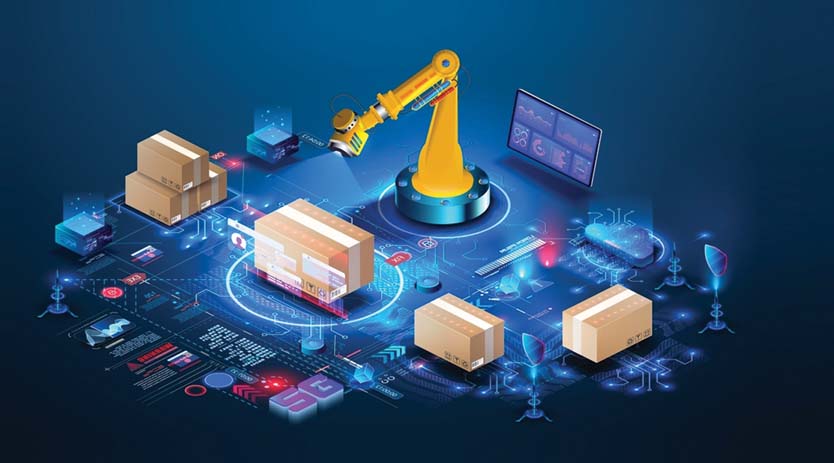Supply chain optimisation shaping smart factories
By OEM Update Editorial December 2, 2022 10:51 am IST
Industry experts from robotics, sensors, traceability solutions, and digital solutions segment shared their insights on tracking assets and supply chain optimisation to enhance productivity.
India, like other countries, views manufacturing as vital to the country’s digital transformation strategy. Automation is required to optimise production and supply chain efficiency. Automation with digital data connectivity for supply chain optimisation is critical. A continuous supply chain includes digital and traceability solutions that detect product defects and improve production efficiency. Product counterfeiting can result in lost revenues and a negative brand reputation. Anti-counterfeit solutions detect tampered labelling and any supply chain irregularities, thus providing end-to-end visibility in the supply chain.
The digital manufacturing industry is growing and is expected to reach $767.82 billion by 2025. Innovative solutions addressing measures that shape smart factories must be deployed across supply chain networks. Certainly, bar codes, tags, and GPS tracking solutions increase supply chain transparency in various industries. The pharmaceutical industry is the most sensitive to packaging, labelling, distribution, and other solutions. Traceability solutions improve supply chain authenticity by utilising intelligent sensors. Robotics processes improve optimisation and eliminate defective products going to waste, resulting in a robust supply chain network.
Technology recommendations for smart factory scenario
Recently, India has been investing in digitisation. Technology is an ongoing process that must be improved regularly, whether it is a supply chain system, manufacturing, or any other form. Otherwise, a company will fall behind and lose business. Dr. Vijay Kalantri, President of the All India Association of Industries, suggests, “One should get acquainted with what is going on in the world to where new technologies are to be used and what best products can be used.” Of course, there is a procedure in pharma. During Covid, we declared that India had established. We previously had a brand name in IT and are now establishing a brand name in the pharmaceutical sector. In terms of technology, the pharmaceutical industry has performed admirably. Similarly, we can create brand names in any industry.”
Every manufacturing item has a process, whether it is raw material to manufacturing, manufacturing to packaging, labelling, delivery, and networking or whatever way it is addressed. Technology must be advanced. Today, India’s cost to GDP is 6.8 percent, while the rest of the world produces 3.4 percent. It is not a matter of technology; it could be a bad road, communication, or network. However, technology has advanced over the years. Companies that have improved digitisation and used the best technology have succeeded and done well. “The three things are interconnected: innovative, improve technology, and go for digitisation and they are all important for improving the supply chain system”, adds Dr. Vijay.
Of course, the best technology available must be used, as well as its affordability. For example, a company may have the best technology and product available, but it needs to market more effectively. There is no value if there is no product acceptability in the world. As a result, it is assumed and said to have arrived ahead of time. Many products and people have arrived ahead of schedule in many areas. Every company should pursue the best-suited technology in India and for the international market, as well as growth factors and innovation technology. All of these are ongoing processes.
Most industries, such as engineering and automotive, are doing well today, and fortunately, the next ten years are India’s decade. To move forward, be innovative with versed digitisations and technological changes. If we expect to grow at 6.5 percent to 7 percent or 7.2 percent this year, we can expect to grow at 8 percent or even 13 percent the following year. However, a technology supply chain system and digital networking must be in place.
With a system in place, people will eventually retain the market. And recovering lost market share is extremely difficult. Exports have surpassed Rs. 400 crores.
The supply chain has also been disrupted due to the Ukraine-Russia war. Companies must provide the best technology and supply chain system to be competitive and become market leaders. To achieve this, positive thinking all the time to transform the processes would be of immense value.
Smart factories in the present times
Adopting connected and intelligent digital technologies enables smart factories to enhance productivity, profitability, compliance, and customer delight. Sharing his thoughts about smart factories from various perspectives, Mr. Amitabh Chaturvedi, Founder and Director, InnovaPoint Infotech Pvt. Ltd., elucidates that the foremost angle to look at a smart factory is from the data side; the second is the human side and thirdly the perspective from the overall side.
A smart factory can provide real-time and accurate data for the entire operation. To begin with, there are three stages. One is ‘all operations,’ which implies end-to-end processes. For example, everything from pressure dye casting to heat treatment to machining and finally to the customer is an end-to-end operation. Real-time, accurate data includes how operations are progressing and how assets perform.
After obtaining data, the next step is to begin optimising the shop. So, take the data and improve its quality. The QR code, five C (critical) parts, the engine block, the engine head, connecting rod, and that can be considered for process control and history. This is an example of how to use data. Another example is using this data to improve productivity. The second stage of the smart factory vision has come to an end.
The third step is to provide enough data to the system about our operations, factory, assets, and everything else to optimise. “AI and other technologies are also used.” As a result, the system can predict whether it is predictive maintenance, predictive tool changes, or any other insights produced by the system. In a nutshell, the data angle is one of the smart factory visions.”
People in India are still trying to figure out what Industry 4.0 can do for them. So, while industry experts have begun to discuss 5G and Industry 5.0, we are still a long way from meaningfully implementing it. Most customers are still in the inquiry stage, moving slowly in various manufacturing areas. According to Mr. Anil Sagar, Director of Renata Envirocom Pvt. Ltd., “Supply chain management involves the most important aspects where IoT, industrial IoT, and industry 4.0 are used.” Right now, supply chain management and manufacturing are critical areas for both of these technologies.” Some clients, for example, are interested in obtaining data from various machines, such as conventional machines, CNC machines, or even robots. They’re looking into how they can use technology and data to improve operations. Thus, optimising operations aids in cost reduction and product quality. For example, one of the customers who implemented an industry 4.0 solution saw a 15 percent increase in revenue, which exceeded expectations. People are starting to use these technologies. Industry 4.0 is undeniably present.
Other than machinery, where we want to use IoT solutions, it can optimise utilities, the energy part of it, compressed air or water used in a factory. As a result, everything can be optimised. Industrial IoT can be used for security as well as a variety of other purposes. It was originally used for energy management but is now used for various other utilities and environmental sensors. People are beginning to consider this in their own homes, given the level of pollution we have.
As a result, everyone is becoming more aware, and they have begun using industrial IoT to improve on various fronts. Finally, robotics is an important field in which people use robots for welding and other purposes. They are also attempting to use data to optimise robot operations, as robots alone will not achieve your objectives. That data must also be used to optimise overall production. So all three areas are getting warmer, and many people are using it.
End-to-end visibility in the supply chain
End-to-end visibility in the supply chain indicates efficiency and how to use the entire workplace better. According to Mr. Rizwan Khan, Sales Manager-India, Supply Point Systems, “Factory automation is the primary point where MSMEs are looking forward to having these types of industries at their end.” It’s not just the more prominent industries or the larger scale that is also looking into this. MSMEs account for approximately 80 percent of the industry eager to participate. When we consider end-to-end visibility as a manager, general manager, or CEO, there should be transparency and control over the entire supply chain process. A dashboard can show live depictions of various parameters such as machines, tooling, processes, people, man-hours invested, etc. End-to-end visibility entails keeping an eye on the material movement that happens.
Micro-level control refers to how inventory is generated, tracked and stored in the stock area, transported to the production floor, and consumed. Also, who used how many of those items on what job, what machine, and so on to arrive at real-time consumption, real-time parameters that are measured daily? End-to-end management is all about obtaining raw materials for a pre-order, also known as an order management system. With a better ordering mechanism, end-to-end visibility exists.

Digital solutions to detect the location
“Asset tracking is a very important trend that is emerging in terms of overall supply chain efficiency,” says Mr. Preetesh Singh, NRI Consulting and Solutions India Pvt. Ltd. It is simple but crucial for selecting the physical layer, gateway layer, or platform level. For instance, several orders were being delivered from one location to another because the challenges before Covid in terms of volatility, management of generated data, or visibility was probably less severe than they became after Covid. Now, many simple digital solutions are being deployed to address such challenges during the transport of possibly some items from one location to another. The electrification component is another example. As a result, numerous digital solutions for electric vehicles that address the vehicle’s flaws are emerging. Assume that one vehicle goes from one location to another for last-mile delivery. There may be some issues with batteries, motors, other components or even the vehicle; consequently, those are also detected simultaneously. The solutions are mostly developed by organisations with a long history of working with such technologies. And, if vehicles are being moved from one location to another without the owner’s permission, new geofencing-based vehicle detection technologies are emerging.
Future optimistic
Smart factories are changing the face of manufacturing. Industry 4.0 intelligent machines enable organisations worldwide to produce more, higher-quality inventory in less time and at a lower cost. According to Mr. Anil, there has been such a surge of interest in these technologies that everyone wants to monitor their machines, equipment, and assets remotely. Now some solutions allow for remote control by customers. Now the controls are moved to the web, and there is a lot of opportunity right now and a lot of interest.
There has been tremendous progress over the last decade. Mr. Preetesh says that Industry 4.0 has been widely adopted, and numerous use cases exist. Indian companies are also performing far better than global organisations in providing solutions and taking the lead. Further, digital solutions will be crucial around electric vehicles that are now getting well-defined. However, vehicle issues and challenges can only be solved by implementing digital solutions. There is a need for the industry service providers to prepare and develop solutions so that they all can take the lead in this area with the arrival of global giants’ arrival. Mr. Amitabh feels these are exciting times as we strive to become a global manufacturing hub. The industry bodies are raising awareness, and early adopters are beginning to invest, and the good news is that the ROIs are often very quick by implementing technologies. Concurring with his viewpoint Mr. Rizwan also expresses that we should all raise awareness in the industry and see how we can help it perform much better with digitalisation.
On a final note, extended reality technologies such as augmented and virtual reality will play an increasingly important part in manufacturing, from enhanced product design, better production planning, augmenting human abilities on assembly lines, and more immersive training. Worldwide, Industry 4.0 is fuelling the emergence of smart factories across diverse industry verticals, including FMCG, automotive, healthcare, aerospace, defence, etc. Dr. Vijay asserts, “We are in the best of the markets where all intellectual people or the companies who are prompt and efficient to embrace the ongoing opportunities go along with the system.” With smart factories re-imagining manufacturing jobs, there is a growing need for professionals savvy with emerging technologies to lead the digital transformation in the sector.
Consequently, the evolution of technology is an ongoing process for both innovation and technology. So, be on the lookout for any technology coming to the fore worth implementing. It is evocative for constantly developing a supply chain system, embracing technology and being innovative in shaping smart factories for the future across the manufacturing industry as it attempts to automate its operational processes within manufacturing environments.
Cookie Consent
We use cookies to personalize your experience. By continuing to visit this website you agree to our Terms & Conditions, Privacy Policy and Cookie Policy.
















